
The University of Sheffield is a public research university in Sheffield, South Yorkshire, England. It received its royal charter in 1905 as successor to the University College of Sheffield, which was established in 1897 by the merger of Sheffield Medical School, Firth College (1879) and Sheffield Technical School (1884).

Oxford Brookes University is a public university in Oxford, England. It can trace its origins to 1865, when it was founded as the Oxford School of Art. It became a university in 1992 and was renamed to honour its former principal, John Henry Brookes, the only one of the new universities to be named after its founder.

The Oxford University Museum of Natural History, sometimes known simply as the Oxford University Museum or OUMNH, is a museum displaying many of the University of Oxford's natural history specimens, located on Parks Road in Oxford, England. It also contains a lecture theatre which is used by the university's chemistry, zoology and mathematics departments. The museum provides the only public access into the adjoining Pitt Rivers Museum.
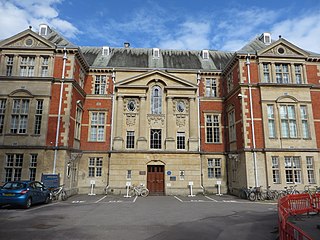
The Clarendon Laboratory, located on Parks Road within the Science Area in Oxford, England, is part of the Department of Physics at Oxford University. It houses the atomic and laser physics, condensed matter physics, and biophysics groups within the Department, although four other Oxford Physics groups are not based in the Clarendon Lab. The Oxford Centre for Quantum Computation is also housed in the laboratory.

The Dyson Perrins Laboratory is in the science area of the University of Oxford and was the main centre for research into organic chemistry of the University from its foundation in 1916 until its closure as a research laboratory in 2003. Until 2018, parts of the building were used as teaching laboratories in which undergraduate students were trained in practical organic chemistry.
The Department of Materials at the University of Oxford, England was founded in the 1950s as the Department of Metallurgy, by William Hume-Rothery, who was a reader in Oxford's Department of Inorganic Chemistry. It is part of the university's Mathematical, Physical and Life Sciences Division

The Physical and Theoretical Chemistry Laboratory (PTCL) is a major chemistry laboratory at the University of Oxford, England. It is located in the main Science Area of the university on South Parks Road. Previously it was known as the Physical Chemistry Laboratory.
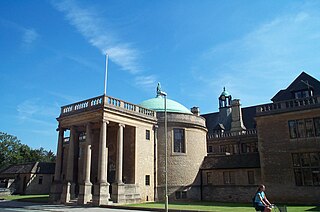
South Parks Road is a road in Oxford, England. It runs east-west past the main Science Area of the University of Oxford. Many of the university science departments are located nearby or face the road, including parts of the geography, zoology, chemistry, psychology and physiology departments. Also on the road is Rhodes House.

Parks Road is a road in Oxford, England, with several Oxford University colleges along its route. It runs north-south from the Banbury Road and Norham Gardens at the northern end, where it continues into Bradmore Road, to the junction with Broad Street, Holywell Street and Catte Street to the south.

Keble Road is a short road running east–west in central Oxford, England. To the west is the southern end of the Banbury Road with St Giles' Church opposite. To the east is Parks Road with the University Parks opposite. Blackhall Road leads off the road to the south near the western end.
The Engineering Campus is the colloquial name for the portions of campus surrounding the Bardeen Quadrangle and the Beckman Quadrangle at the College of Engineering at the University of Illinois at Urbana–Champaign. It is an area of approximately 30 square blocks, roughly bounded by Green Street on the south, Wright Street on the west, University Avenue on the north, and Gregory Street on the east.

The Oxford University Science Area in Oxford, England, is where most of the science departments at the University of Oxford are located.
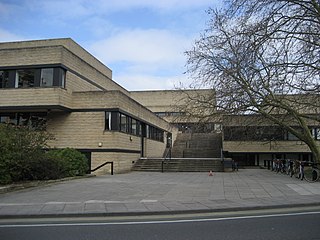
The Bodleian Law Library (BLL) is an academic library in Oxford, England. It is part of Oxford University, the Bodleian Libraries and is also the library of the Faculty of Law. It is situated in part of the Grade II*-listed St Cross Building on St Cross Road in the parish of Holywell, on the corner of Manor Road.

The Clapp/Langley/Crawford halls complex, comprises three inter-connected buildings and the Life Science Annex that house the Department of Biological Science and the Department of Neuroscience at the University of Pittsburgh in Pittsburgh, Pennsylvania, United States.
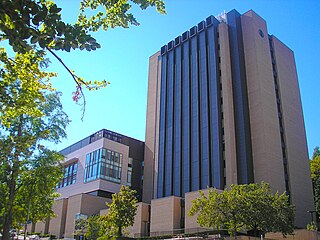
Chevron Science Center is a landmark academic building at 219 Parkman Avenue in Pittsburgh, Pennsylvania, United States on the campus of the University of Pittsburgh. The 15-story facility, completed in 1974, was designed by Kuhn, Newcomer & Valentour and houses the university's chemistry department. A three-story addition above Ashe Auditorium was completed in 2011.

The Alan Turing Building, named after the mathematician and founder of computer science Alan Turing, is a building at the University of Manchester, in Manchester, England. It houses the School of Mathematics, the Photon Science Institute and the Jodrell Bank Centre for Astrophysics. The building is located in the Chorlton-on-Medlock district of Manchester, on Upper Brook Street, and is adjacent to University Place and the Henry Royce Institute. While under construction the project was known as AMPPS : Astronomy, Mathematics, Physics and Photon Science. The building was shortlisted for the Greater Manchester Building of the Year 2008 prize, which is awarded by the Greater Manchester Chamber of Commerce. The manager of the building project was awarded a silver medal in the Chartered Institute of Building "Construction Manager of the Year" awards.
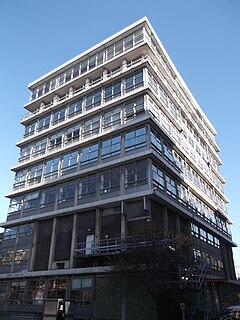
The Department of Engineering Science is the academic department dedicated to teaching and researching engineering at the University of Oxford, which is part of the university's Mathematical, Physical and Life Sciences Division. It is located on the triangular plot formed by Banbury Road to the west, Parks Road to the east and Keble Road to the south. The main building is the tall 1960s Thom Building that dominates the local landscape, especially the view from the University Parks to the east. Further lower buildings have been added to the north since then. The department shares buildings with the Department of Materials.

The Department of Physics is the physics department of the University of Oxford, England, which is part of the university's Mathematical, Physical and Life Sciences Division. The department is based in the Science Area, mainly on Parks Road, Oxford, England, just south of the University Parks. It was originally established at the Clarendon Laboratory in 1872 and this is now part of the Department.

The Abbot's Kitchen in Oxford, England, is an early chemistry laboratory based on the Abbot's Kitchen at Glastonbury Abbey, a mediaeval 14th-century octagonal building that served as the kitchen at the abbey.


















